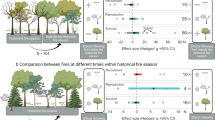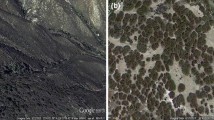Abstract
Resprouting has emerged as a key functional trait in plant ecology over the past decade with more than 400 papers published since 2000 (Web of Science). This special issue of Plant Ecology brings together a set of papers that advance our understanding of this functional trait, in the quest for developing a better conceptual framework for predicting community response to disturbance. This special issue highlights current research on all aspects of the effects of fire and other disturbances on plant resprouting behaviour and the importance of the persistence niche in structuring plant communities.
Similar content being viewed by others
References
Adie H, Richert S, Kirkman KP, Lawes MJ (2011) The heat is on: frequent high intensity fire in bracken (Pteridium aquilinum) drives mortality of the sprouting tree Protea caffra in temperate grasslands. Plant Ecol 12:2013–2022
Bell DT (2001) Ecological response syndromes in the flora of southwestern Western Australia: fire resprouters versus reseeders. Bot Rev 67:417–440
Bellingham PJ, Sparrow AD (2000) Resprouting as a life history strategy in woody plant communities. Oikos 89:409–416
Bellingham PJ, Sparrow AD (2009) Multi-stemmed trees in montane rain forests: their frequency and demography in relation to elevation, soil nutrients and disturbance. J Ecol 97:472–483
Bond WJ, Midgley JJ (2001) Ecology of sprouting in woody plants: the persistence niche. Trends Ecol Evol 16:45–51
Bond WJ, Midgley JJ (2003) The evolutionary ecology of sprouting in woody plants. Int J Plant Sci 164:S103–S114
Bond WJ, Midgley GF, Woodward FI (2003) The importance of low atmospheric CO2 and fire in promoting the spread of grasslands and savannas. Global Change Biol 9:973–982
Bowman DMJS, Balch JK, Artaxo P, Bond WJ, Carlson JM, Cochrane MA, D’Antonio CM, DeFries RS, Doyle JC, Harrison SP, Johnston FH, Keeley JE, Krawchuk MA, Kull CA, Marston JB, Moritz MA, Prentice IC, Roos CI, Scott AC, Swetnam TW, van der Werf GR, Pyne SJ (2009) Fire in the earth system. Science 324:481–484
Burrows GE (2002) Epicormic strand structure in Angophora, Eucalyptus and Lophostemon (Myrtaceae)—implications for fire resistance and recovery. New Phytol 153:111–131
Burrows GE, Hornby SK, Waters DA, Bellairs SM, Prior LD, Bowman DMJS (2008) Leaf axil anatomy and bud reserves in 21 Myrtaceae species from northern Australia. Int J Plant Sci 169:1174–1186
Chew SJ, Bonser SP (2009) The evolution of growth rate, resource allocation and competitive ability in seeder and resprouter tree seedlings. Evol Ecol 23:723–735
Clarke PJ, Knox KJE (2009) Trade-offs in resource allocation that favour resprouting affect the competitive ability of woody seedlings in grassy communities. J Ecol 97:1374–1382
Clarke PJ, Lawes MJ, Midgley JJ (2010) Resprouting as a key functional trait in woody plants—challenges to developing new organizing principles. New Phytol 188:651–654
Crisp MD, Burrows GE, Cook LG, Thornhill AH, Bowman DMJS (2011) Flammable biomes dominated by eucalypts originated at the Cretaceous–Palaeogene boundary. Nat Commun 2:193. doi:10.1038/ncomms1191
Cruz A, Perez B, Moreno JM (2003) Plant stored reserves do not drive resprouting of the lignotuberous shrub Erica australis. New Phytol 157:251–261
Denton MD, Veneklaas EJ, Freimoser FM, Lambers H (2007) Banksia species (Proteaceae) from severely phosphorus impoverished soils exhibit extreme efficiency in the use and re-mobilisation of phosphorus. Plant Cell Environ 30:1557–1565
Dickinson HG, Grant-Downton R (2009) Bridging the generation gap: flowering plant gametophytes and animal germlines reveal unexpected similarities. Biol Rev 84:589–615
Enright NJ, Mosner E, Miller BP, Johnson N, Lamont BB (2007) Patterns of soil versus canopy seed storage and plant species coexistence in species-rich shrublands of southwestern Australia. Ecology 88:2292–2304
Enright NJ, Fontaine JB, Westcott VC, Lade JC, Miller BP (2011) Fire interval effects on persistence of resprouter species in Mediterranean-type shrublands. Plant Ecol 12:2071–2083
Goorman R, Bartual A, Paula S, Ojeda F (2011) Enhancement of photosynthesis in post-disturbance resprouts of two co-occurring Mediterranean Erica species. Plant Ecol 12:2023–2033
Groom PK, Lamont BB (1996) Reproductive ecology of nonsprouting and resprouting species of Hakea (Proteaceae) in SWA. In: Hopper SD, Chappill JA, Harvey MS, George AS (eds) Gondwanan heritage. Past, present and future of the Western Australian biota. Surrey Beatty and Sons, Chipping Norton, pp 239–248
Groom PK, Lamont BB (2011) Regional and local effects on reproductive allocation in epicormic and lignotuberous populations of Banksia menziesii. Plant Ecol 12:2003–2011
Hernández EI, Pausas JG, Vilagrosa A (2011) Leaf physiological traits in relation to resprouter ability in the Mediterranean Basin. Plant Ecol 12:1959–1966
Keeley JE, Pausas JG, Rundel PW, Bond WJ, Bradstock RA (2011) Fire as an evolutionary pressure shaping plant traits. Trends Plant Sci 16:406–411
Knox KJE, Clarke PJ (2005) Nutrient availability induces contrasting allocation and starch formation in resprouting and obligate seeding shrubs. Funct Ecol 19:690–698
Knox KJE, Clarke PJ (2011) Fire severity and nutrient availability do not constrain resprouting in forest shrubs. Plant Ecol 12:1967–1978
Lamont BB, Downes KS (2011) Fire-stimulated flowering among resprouters and geophytes in Australia and South Africa. Plant Ecol 12:2111–2125
Lamont BB, Wiens D (2003) Are seed set and speciation rates always low among species that resprout after fire, and why? Evol Ecol 17:277–292
Lamont BB, Enright NJ, He T (2011) Fitness and evolution of resprouters in relation to fire. Plant Ecol 12:1945–1957
Lasso E, Engelbrecht BMJ, Dalling JW (2009) When sex is not enough: ecological correlates of resprouting capacity in congeneric tropical forest shrubs. Oecologia 161:43–56
Lawes MJ, Adie H, Russell-Smith J, Murphy B, Midgley JJ (2011a) How do small savanna trees avoid stem mortality by fire? The roles of stem diameter, height and bark thickness. Ecosphere 2:art42. doi:10.1890/ES10-00204.1
Lawes MJ, Richards A, Dathe J, Midgley JJ (2011b) Bark thickness determines fire resistance of selected tree species from fire-prone tropical Savanna in North Australia. Plant Ecol 12:2057–2069
Midgley JJ, Lawes MJ, Chamaillé-Jammes S (2010) Savanna woody plant dynamics; the role of fire and herbivory, separately and synergistically. Aust J Bot 58:1–11
Nano CEM, Clarke PJ (2011) How do drought and fire influence the patterns of resprouting in Australian deserts? Plant Ecol 12:2095–2110
Nzunda EF, Lawes MJ (2011) Costs of resprouting are traded off against reproduction in subtropical coastal dune forest trees. Plant Ecol 12:1991–2001
Nzunda EF, Griffiths ME, Lawes MJ (2008) Sprouting by remobilization of above-ground resources ensures persistence after disturbance of coastal dune forest trees. Funct Ecol 22:577–582
Paula S, Ojeda F (2009) Belowground starch consumption after recurrent severe disturbance in three resprouter species of the genus Erica. Botany 87:253–259
Paula S, Ojeda F (2011) Response to recurrent disturbance in two co-occurring resprouter heath species: the ecological consequences of withstanding herbivores. Plant Ecol 12:2035–2045
Pausas JG, Bradstock RA (2007) Fire persistence traits of plants along a productivity and disturbance gradient in mediterranean shrublands of south-east Australia. Global Ecol Biogeogr 16:330–340
Pausas JG, Bradstock RA, Keith DA, Keeley JE (2004) Plant functional traits in relation to fire in crown-fire ecosystems. Ecology 85:1085–1100
Power SC, Cramer MD, Verboom GA, Chimphango SBM (2011) Legume seeders of the Cape floristic region inhabit more fertile soils than congeneric resprouters—sometimes. Plant Ecol 12:1979–1989
Schutz AEN, Bond WJ, Cramer MD (2009) Juggling carbon: allocation patterns of a dominant tree in a fire-prone savanna. Oecologia 160:235–246
Schutz A, Bond W, Cramer M (2011) Defoliation depletes the carbohydrate reserves of resprouting Acacia saplings in an African savanna. Plant Ecol 12:2047–2055
Tolsma AD, Tolhurst KG, Read SM (2010) Effects of fire, post-fire defoliation, drought and season on regrowth and carbohydrate reserves of alpine snowgrass Poa fawcettiae (Poaceae). Aust J Bot 58:157–168
Vallejo-Marín M, Dorken ME, Barrett SCH (2010) The ecological and evolutionary consequences of clonality for plant mating. Annu Rev Ecol Evol Syst 41:193–213
Verdú M, Pausas JG, Segarra-Moragues JG, Ojeda F (2007) Burning phylogenies: fire, molecular evolutionary rates, and diversification. Evolution 61:2195–2204
Vesk PA, Westoby M (2004) Sprouting ability across diverse disturbances and vegetation types worldwide. J Ecol 92:310–320
Winter SL, Fuhlendorf SD, Goad CL, Davis CA, Hickman KR, Leslie DM Jr (2011) Fire tolerance of a resprouting Artemisia (Asteraceae) shrub. Plant Ecol 12:2085–2093
Acknowledgments
We are grateful to Neal Enright, Byron Lamont, Jeremy Midgley and Fernando Ojeda for constructive comments that helped improve this editorial. We thank the ARC-NZ Vegetation Function Network for funding support to Working Group 67 on plant resprouting (http://www.vegfunction.net/wg/67/67_Sprouting.htm) that made this special issue of Plant Ecology possible. We thank the participants of WG67 for providing a stimulating and collaborative environment and for their contribution to this special issue.
Author information
Authors and Affiliations
Corresponding author
Rights and permissions
About this article
Cite this article
Lawes, M.J., Clarke, P.J. Ecology of plant resprouting: populations to community responses in fire-prone ecosystems. Plant Ecol 212, 1937–1943 (2011). https://doi.org/10.1007/s11258-011-9994-z
Received:
Accepted:
Published:
Issue Date:
DOI: https://doi.org/10.1007/s11258-011-9994-z




